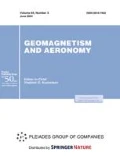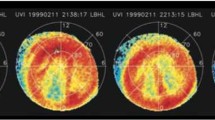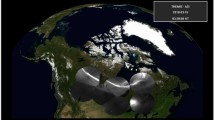Abstract
The auroral oval concept radically changed the view that existed for a century in geophysics on the patterns in aurora planetary spatial–temporal distributions. The auroral zone, which is located around the geomagnetic pole as a continuous ring at a constant angular distance of ~23°, was replaced by the auroral oval in 1960. The auroral oval spatial position reflects the shape of the Earth’s magnetosphere, which is compressed by the solar wind on the dayside and stretches into the magnetotail on the nightside. The oval is fixed relative to the direction toward the Sun and is located around the geomagnetic pole at altitudes of the upper atmosphere at an angular distance of ~12° at noon and ~23° at midnight. After an animated discussion over several subsequent years, the existence of the auroral oval was accepted by the scientific community as a paradigm of a new science, i.e., solar–terrestrial physics. The oval location indicates the zone where electron fluxes with energies varying from ~100 eV to ~20 keV precipitate into the upper atmosphere and is related to the structure of plasma domains in the Earth’s magnetosphere. The paper describes the scientific studies that resulted in the concept of the auroral oval existence. It has been shown how this concept was subsequently justified in the publications by Y.I. Feldstein and O.B. Khorosheva. The issue of the priority of the auroral oval concept introduction into geophysics has been considered. The statement that the concept of the oval is an archaic paradigm of solar–terrestrial physics has been called into question. Some scientific fields in which the term auroral oval or simply oval was and is the paradigm have been listed.
Similar content being viewed by others
References
Akasofu, S.-I., More details on early auroral research, EOS, vol. 92, no. 23, p. 196.
Akasofu, S.-I., Polar and Magnetospheric Substorms, Dordrecht: D. Reidel, 1968).
Alfvén, H., Theory of magnetic storms and aurorae, K. Sven. Vetenskapsakad. Handl., Ser. 3, 1939, vol. 18, no. 3, pp. 1–28.
Alfvén, H., Theory of magnetic storms and aurorae, K. Sven. Vetenskapsakad. Handl., Ser. 3, 1940, vol. 18, no. 9, pp. 1–42.
Alfvén, H., Cosmical Electrodynamics, Oxford: Clarendon, 1950).
Alfvén, H., On the electric theory of magnetic storms and auroras, Tellus, 1955, vol. 7, no. 1, pp. 50–64.
Alfvén, H., Note on the “auroral oval”, J. Geophys. Res., 1967, vol. 72, no. 13, pp. 3503–3505.
Auroral Ascaplots, Annals of the International Geophysical Year, vol. 20, part 1, Pergamon, 1962).
Bartels, J. and Fukushima, N., Ein Q-Index für erdmagnetische Activität in viertelstündlichen Intervalen, Abh. Akad. Wiss. Göettingen, Math.-Phys. Kl., 1956.
Carlheim-Gyllenskiold, V., Exploration internationale des régions polaires, 1882–1883. Observations faites au cap Thordsen, Spitzberg, par l’expédition suédoise. Aurores boréales, K. Sven. Vetenskapsakad. Handl., 1887, vol. 2, no. 1.
Chapman, S., The aurora in middle and low latitudes, Ann. Int. Geophys. Year, 1957, vol. 4, pp. 25–40.
Chernouss, S.A., Starkov, G.V., and Yevlashin, L.S., World first complex optical instrumental observations of aurora in the Arctic in 1899–1900, Ann. Geophys., 2005, vol. 23, pp. 1523–1531.
Chernouss, S. and Sandahl, I., Comparison and significance of auroral studies during the Swedish and Russian bilateral expedition to Spitsbergen in 1899–1900, Ann. Geophys., 2008, vol. 26, pp. 1127–1140. Citation Classic, 1980). no. 19.
Feldshtein, Ya.I., Geographic distribution of auroras in the west sector of Soviet Arctic, Probl. Arkt., 1958, no. 4, pp. 45–49.
Feldshtein, Ya.I., Geographic distribution of auroras and arc azimuths, Issled. Polyarn. Siyanii, 1960, no. 4, pp. 61–77.
Feldshtein, Ya.I., Some issues of auroral morphology and magnetic disturbances at high latitudes, Geomagn. Aeron., 1963a, vol. 3, no. 2, pp. 227–239.
Feldshtein, Ya.I., Auroral morphology and geomagnetism, Polyarn. Siyaniya Svechenie Nochnogo Neba, 1963b, no. 10, pp. 121–125.
Feldstein, Y.I., Peculiarities in the auroral distribution and magnetic disturbance distribution in high-latitudes caused by the asymmetrical form of the magnetosphere, Planet. Space Sci., 1966, vol. 14, no. 2, pp. 121–130.
Feldshtein, Ya.I., Distribution of auroras and magnetic disturbances at high latitudes due to magnetospheric asymmetry, Polyarn. Siyaniya Svechenie Nochnogo Neba, 1967, no. 13, pp. 98–118.
Feldstein, Y.I., A quarter of a century with the auroral oval, History of Geophysics, Washington, DC: AGU, 1990, vol. 4, pp. 103–108.
Feldstein, Y.I., Khorosheva, O.V., and Lebedinski, A.I., Investigations of auroral planetary distribution, J. Phys. Soc. Jap., 1962, vol. 17, pp.149–154.
Feldshtein, Ya.I. and Shevnina, N.F., Results of visual observations over auroras in 1957–1958, Polyarn. Siyaniya Svechenie Nochnogo Neba, 1963, no. 10, pp. 98–118.
Feldshtein, Ya.I. and Solomatina, E.K., Some issues of geographic distribution of auroras in the Northern Hemisphere, Polyarn. Siyaniya Svechenie Nochnogo Neba, 1961a, no. 7, pp. 51–60.
Fel’dshtein, Ya.I. and Solomatina, E.K., Auroras in the Southern Hemisphere, Geomagn. Aeron., 1961b, vol. 1, no. 4, pp. 534–539.
Feldstein, Y.I. and Starkov, G.V., Dynamics of auroral belt and polar geomagnetic disturbances, Planet. Space Sci., 1967, vol. 15, no. 2, pp. 209–229.
Feldstein, Y.I., Isaev, S.I., and Lebedinsky, A.I., The phenomenology and morphology of aurorae, Ann. IQSY, 1969, vol. 4, pp. 311–348.
Feldstein, Y.I., Gromova, L.I., Forster, M., and Levitin, A.E., Spiral regularities in magnetic field variations and auroras, Hist. Geophys. Space Sci., 2012, vol. 3, pp. 1–31. doi 10.5194/hgss-3-1-2012
Frank, L.A., Van-Allen, J.A., and Craven, J.D., Large diurnal variation of geomagnetically trapped and of precipitated electrons observed at low altitudes, J. Geophys. Res., 1964, vol. 69, no. 15, pp. 3155–3167.
Fritz, H., Das Polarlight, Leipzig: Brockhaus, 1881).
Galperin, Yu.I. and Feldstein, Y.I., Mapping of the precipitation regions to the plasma sheet, J. Geomagn. Geoelectr., 1996, vol. 48, pp. 857–875.
Gorchakov, E.V., Spatial location of the Earth’s outer radiation belt and the auroral zones, Iskusstv. Sputniki Zemli, 1961a, no. 8, pp. 81–83.
Gorchakov, E.V., The outer radiation belt and aurora, Iskusstv. Sputniki Zemli, 1961b, no. 9, pp. 66–70.
Gustafsson, G., Feldstein, Y.I., and Shevnina, N.F., The auroral orientation curves for the IQSY, Planet. Space Sci., 1969, vol. 17, pp. 1657–1667.
Hultqvist, B., The geomagnetic field lines in higher approximation, Ark. Geofys., 1958, vol. 3, pp. 53–68.
Hultqvist, B., On the orientation of auroral arcs, J. Atmos. Terr. Phys., 1962, vol. 24, no. 1, pp. 17–30.
Hultqvist, B., Egeland, A., and Gustafsson, G., A morning discontinuity in the orientation of quiet auroral arcs, Nature, 1961, vol. 192, no. 4806, pp. 956–958.
Isaev, S.I., On the diurnal periodicity of aurora in the maximum frequency zone, Probl. Arkt., 1940, no. 9, pp. 41–45.
Jørgensen, T.S., On the history of auroral research, EOS, 2011, vol. 92, no. 23, p. 196. doi 10.1029/211E0230005
Khorosheva, O.V., Spatial and temporal distribution of auroras and their relation to high-latitude geomagnetic disturbances, Geomagn. Aeron., 1961, vol. 1, pp. 695–701.
Khorosheva, O.V., Diurnal drift of the closed auroral ring, Geomagn. Aeron., 1962, vol. 2, no. 5, pp. 839–850.
Khorosheva, O.V., The length of auroral arcs and their spatial orientation, Geomagn. Aeron., 1963, vol. 3, no. 2, pp. 363–366.
Khorosheva, O.V., Prostranstvenno-vremennoe raspredelenie polyarnykh siyanii (Spatial and Temporal Distribution of Auroras), Moscow: Nauka, 1967).
Krasovskii, V.I., Auroras, Geomagn. Aeron., 1967, vol. 7, no. 6, pp. 945–957.
Lassen, K., Day-Time Auroras Observed at Godhavn, 1954.56, Charlottenlund: Det Danske Meteorologiske Institut, 1961. vol. 15.
Lassen, K., Geographical Distribution and Temporal Variations of Polar Aurorae, Charlottenlund: Charlottenlund: Det Danske Meteorologiske Institut, 1963). vol. 18.
Lassen, K., Existence of an inner auroral zone, Nature, 1959, vol. 184, no. 4696, pp. 1375–1377.
Lazutin, L.L., Mirovye i polyarnye magnitnye buri (World and Polar Magnetic Storms), Moscow: NIIYaF MGU, 2012).
Lazutin, L.L., Auroral oval—a wonderful yet obsolete paradigm, Soln.-Zemnaya Fiz., 2015, vol. 1, no. 1, pp. 23–35.
McIlwain, C.E., Direct measurement of protons and electrons in visible auroras, J. Geophys. Res., 1960, vol. 65, no. 9, pp. 2727–2747.
Moss, K. and Stauning, P., Sophus Peter Tromholt: An outstanding pioneer in auroral research, Hist. Geophys. Space Sci., 2012, vol. 3, pp. 53–72. doi 10.5194/hgss-353-2012
Nikol’skii, A.P., On the second zone of increased intensity of magnetic disturbances in the near-polar region, Tr. Arkt. Antarkt. Nauchno-Issled. Inst., 1956, vol. 83, pp. 5–83.
Nikol’skii, A.P., O planetarnom raspredelenii magnitnoionosfernykh vozmushchenii, Tr. Arkt. Antarkt. Nauchno-Issled. Inst., 1960, vol. 223, pp. 3–20.
O’Brien, B.J., A large diurnal variation of the geomagnetically trapped radiation, J. Geophys. Res., 1963, vol. 68, no. 4, pp. 989–995.
Pushkov, N.V., Brunkovskaya, N.S., and Abramova, N.V., Comparison between magnetic activity and auroral activity according to observations at the Tikhaya Bay in 1932–1933, Meteorol. Gidrol., 1937, vol. 4, no. 6, pp. 75–83.
Starkov, G.V. and Feldshtein, Ya.I., Auroral arc azimuths according to observations at Dickson Island, Issled. Polyarn. Siyanii, 1960, no. 4, pp. 56–61.
Starkov, G.V. and Feldshtein, Ya.I., Orientation of extended auroral forms, Geomagn. Aeron., 1967, vol. 7, no. 1, pp. 72–77.
Starkov, G.V. and Feldshtein, Ya.I., The auroral belt at magnetic disturbances, Polyarn. Siyaniya Svechenie Nochnogo Neba, 1968, no. 17, pp. 22–33.
Starkov, G.V. and Feldshtein, Ya.I., Instantaneous distribution of auroras and polar geomagnetic disturbances, Polyarn. Siyaniya, 1970, no. 19, pp. 32–41.
Starkov, G.V., Rezhenov, B.V., Vorob’ev, V.G., Feldshtein, Ya.I., and Gromova, L.I., Dayside auroral precipitation structure, Geomagn. Aeron. (Engl. Transl.), 2002, vol. 42, no. 2, pp. 176–183.
Starkov, G.V., Rezhenov, B.V., Vorob’ev, V.G., and Feldshtein, Ya.I., Planetary distribution of auroral precipitation and its relation to the zones of auroral luminosity, Geomagn. Aeron. (Engl. Transl.), 2003, vol. 43, no. 5, pp. 569–578.
Stauning, P., Danish auroral science history, Hist. Geophys. Space Sci., 2011, vol. 2, pp. 1–28. doi 10.5194/hgss-21-2011
Störmer, C., The Polar Aurora, Oxford: Clarendon Press, 1955).
Tromholt, S., Sur les périodes de l’aurore boréale, Copenhagen: Det Danske Meteorologiske Institut, 1882).
Vestine, E.H., The geographic incidence of aurora and magnetic disturbance, northern hemisphere, Terr. Magn. Atmos. Electr., 1944, vol. 49, no. 2, pp. 77–102.
Vorob’ev, V.G., Gromova, L.I., Rezhenov, B.V., Starkov, G.V., and Fel’dshtein, Ya.I., Variations of the boundaries of plasma precipitations and auroral luminosity in the nighttime sector, Geomagn. Aeron. (Engl. Transl.), 2000, vol. 40, no. 3, pp. 344–350.
Author information
Authors and Affiliations
Corresponding author
Additional information
Original Russian Text © Y.I. Feldstein, 2016, published in Geomagnetizm i Aeronomiya, 2016, Vol. 56, No. 2, pp. 139–153.
Rights and permissions
About this article
Cite this article
Feldstein, Y.I. The discovery and the first studies of the auroral oval: A review. Geomagn. Aeron. 56, 129–142 (2016). https://doi.org/10.1134/S0016793216020043
Received:
Published:
Issue Date:
DOI: https://doi.org/10.1134/S0016793216020043




